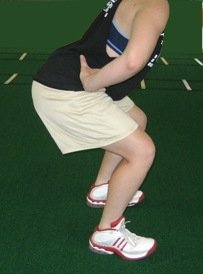Ankle Dorsiflexion:
Are They Restricted?
The first and most important step for treating a dorsiflexion restriction is understanding what is causing it. The easiest way to assess a restriction is to ask an athlete to stand with their feet shoulder width apart and to squat as deep as they can with their heels on the floor. They should be able to reach a full, deep squat with their butt on the heels with their toes straight ahead and heels down. If they can’t, they have a functional dorsiflexion restriction (pictured to right).
But, Why?
The next question becomes, are they restricted because their joint is bound up and full of scar tissue or adhesions? Or, do they have a functional movement pattern which is not allowing them to hit the position that you are asking them to.
Usually, you can asses this by putting them on the table and asking them to dorsiflex as far as they can actively. If they can reach 10-15 degrees of dorsiflexion actively, it is not likely a restriction in the joint and is due to a faulty movement pattern.
If they can’t reach at least 10 degrees actively, then you want to asses them passively. Make sure as you passively take them into dorsiflexion, you start by finding sub talar neutral and keep them in it. Otherwise, you will be allow the athlete to find less restrictive compensation patterns to get around their problem. If they are restricted in the joint, you will feel a very stiff and hard block as you attempt to take them into dorsiflexion.
The Maximum Solution
Now that we have an idea where their restriction is coming from, we need real, easy solutions. First and foremost, if you found that your athlete has a functional dorsiflexion restriction which is not caused by the ankle joint, you need to start evaluating the rest of the body to find the muscular patterns which are faulty and causing them to be restricted when weight bearing. This comes down to understanding how the body works together in unison. Reviewing your functional anatomy will help you with this.
A restricted joint can be dealt with in a variety of ways to loosen the joint capsul and/or break up any scar tissue or adhesions which are present.
- Joint Mobs: Likely the most popular method for solving a true dorsiflexion restriction among sports medicine professionals. While they are extremely effective, it takes a trained and licensed professional who knows what they are doing and has good manual skills to get the most out of a joint mobilization technique.
- Self Joint Mobs: Self joint mobs can be very effective at making smaller, more frequent changes at the ankle by teaching an athlete how to push into the restriction in a controlled and safe manner. The big advantage to a self mobilization is that the athlete can perform them several times during the day, continually making improvements.
- Squatting and Lunging Modifications: This is probably the easiest and best method that you can use for improving ankle dorsiflexion in a team setting with coaches and trainers who recognize a restriction, but don’t have the time or skills to perform manual joint mobilization techniques. They are simple to implement and highly effective.
- Barefoot Training: Barefoot training is one of the new hot techniques used by coaches and trainers for improving performance and decreasing injury risk. Training barefoot can be effective for improving a dorsiflexion restriction because it forces the athlete to dorsiflex during movement. In a pair of shoes, especially many of the running shoes available to day, they will have a heel lift built in and be allowed to push their foot into pronation. Without shoes, they are forced to have better foot structure.
Take time to read and learn about all of the techniques. The bigger the toolbox, the more effective you can be!
Looking for more help? Schedule a consultation today!
Back to Ankle Dorsiflexion
Back to Injury Rehabilitation
Back to Home




Leave a Reply